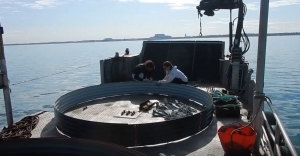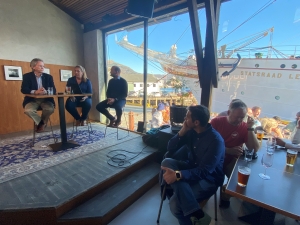Blue swimmer crabs studied at all stages of life in Cockburn Sound surveys
A research team has, for the first time, been able to build a comprehensive picture of the distribution and abundance of blue swimmer crabs in Cockburn Sound over the species’ entire life cycle.
Dr Danielle Johnston, a senior research scientist from the Department of Primary Industries and Regional Development, is leading the collaborative project as part of the WAMSI Westport Marine Science Program.
She said blue swimmer crabs (Portunus armatus) were once the Sound’s biggest commercial fishery but stocks declined in the early 2000s with fishery closures in 2006 and 2014.
While DPIRD researchers have been surveying juvenile and adult blue swimmer crabs in the area for more than 20 years as part of fishery monitoring programs, they hadn’t had the opportunity to survey larvae.
“The juvenile and breeding stock data we have collected over the two years of the WAMSI Westport Marine Science Program builds on the historical data we already have but the collection of crab larvae is something we haven’t been able to achieve before,” Dr Johnston said.
“Collection, identification and counting crab larvae requires highly specialised skills and we were very fortunate to collaborate with scientists at WA Museum to achieve this.”
“This has meant we have a couple of years of data on crab larvae, juveniles and adult breeding stock which gives us a much better understanding of the whole life cycle of the blue swimmer crabs.”
Researchers are investigating the spatio-temporal distribution, or where and at what times of the year, the short-lived crustaceans are most abundant and whether observed trends can be explained by relationships with environmental conditions and habitat.
These findings can then be used to inform the Westport program.
The research team has caught about 8,500 adult blue swimmer crabs and around 1,500 juveniles over the areas of Cockburn Sound and Owen Anchorage which were measured before being returned to the water.
Collecting data on each life history stage has meant using multiple sampling methods.
“We’re looking at all life stages so we used bongo nets and light traps to collect crab larvae, trawl nets to collect juvenile recruits and hourglass traps for adult crabs and breeding stock.”
“Juvenile and adult crabs bury themselves in the sediment during the day and emerge for feeding at night, so much of our sampling occurred at night when the blue swimmer crabs are most active”.
Sampling for this project has now finished and the next stage will be to complete a comprehensive analysis, interpretation and write-up of the data.
But Dr Johnston said preliminary results show abundance was higher in the first year of the sampling in 2021-22.
“Crab abundances will differ from year to year based around environmental conditions, with warmer temperatures generally resulting in higher abundance as blue swimmer crabs are a tropical species,” Dr Johnston said.
Refer to the DPIRD website for the latest information on fishing regulations for blue swimmer crabs: http://rules.fish.wa.gov.au/Species/Index/27


